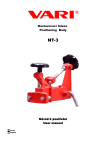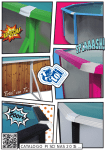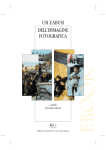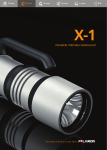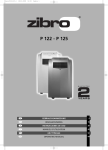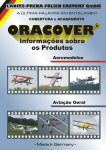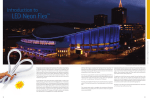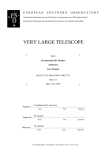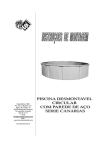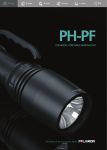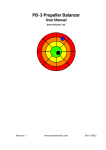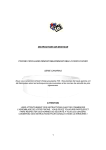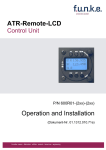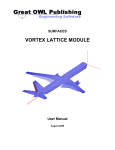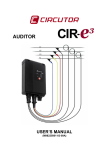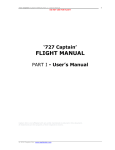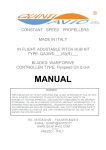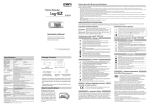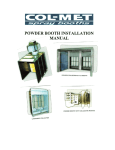Download Flight and Operations Manual of ATEC 321 FAETA (Rotax 912 iS)
Transcript
The Sole Manufacturer and Distributor in Czech Republic: ATEC v.o.s. Factory address: ATEC v.o.s., Opolanská 350, 289 07 Libice nad Cidlinou Czech Republic ATEC 321 FAETA Flight and Operations Manual Libice nad Cidlinou, March 2011 Flight and Operations Manual of ATEC 321 Faeta UL aircraft ATEC v.o.s. Libice nad Cidlinou, Czech Republic Page 1 of 53 Type of aircraft: ATEC 321 FAETA Serial number : Registration/call sign: LAA CR Type Certificate: ULL-04 / 2005 Date of issue: 19. 10. 2005 The aircraft (Sport Flying Device) is not a subject of CAA authorisation and is to be operated at own risk of the user. The aircraft must be operated according to informations and limits listed in this manual. Flight and Operations Manual of ATEC 321 Faeta UL aircraft ATEC v.o.s. Libice nad Cidlinou, Czech Republic Page 2 of 53 Contents Chapter General 1 Operational Limits 2 Emergency Procedures 3 Standard Procedures 4 Performances 5 Assembly, Disassembly 6 Aircraft Description and Systems 7 Maintenance 8 Weight, Centre of Gravity 9 Enclosures: 1. Log Book (example) 2. Records of Revisions 3. Service and Maintenance Book Flight and Operations Manual of ATEC 321 Faeta UL aircraft ATEC v.o.s. Libice nad Cidlinou, Czech Republic Page 3 of 53 Chapter 1 1. General 1.1. 1.2. 1.3. 1.4. 1.5. 1.6. Introduction Personal Data of the Owner Aircraft Description Modifications and Changes Aircraft Technical Data Three-View Sketch Flight and Operations Manual of ATEC 321 Faeta UL aircraft ATEC v.o.s. Libice nad Cidlinou, Czech Republic Page 4 of 53 1.1. Introduction Information provided within this manual is a necessary requirement for an effective and save operation of the ATEC 321 FAETA aircraft. The manual contents information which Manufacturer considers as important. 1.2. Personal Data of the Owner Owner of aircraft: Address: Telephone No: E-mail: Date of ownership from: to: Owner of aircraft: Address: Telephone No: E-mail: Date of ownership from: to: Owner of aircraft: Address: Telephone No: E-mail: Date of ownership from: to: Flight and Operations Manual of ATEC 321 Faeta UL aircraft ATEC v.o.s. Libice nad Cidlinou, Czech Republic Page 5 of 53 1.3. Aircraft Description ATEC 321 FAETA is an ultralight, two-seater, cantilever, low-wing aircraft of all carbon composite construction. The landing gear has a fixed tricycle gear with a steerable front wheel. The power unit is of pulling configuration and consists of ROTAX 912 iS engine and of two-blade or three-blade fix or ground adjustable FITI propeller. 1.4. Modifications and Changes If any structural or operational changes are made by the Manufacturer and need to be advised to the owner, the related documentation will be delivered to you and you are obliged to record them into your Manual. These documents will be published in ascending numerical series. If the aircraft is sold to another person, the Manufacturer shell be announced about the name and the address of the new owner. 1.5. Aircraft Technical Data Dimensions Wing span Length of fuselage Total height Wing area Depth of mean aerodynamic chord Span of horizontal tail surface Flap position I II III Aileron deflection up down Elevator deflection up down Rudder deflection L/R 9,6 m 6,2 m 2,0 m 10,1 m2 1,11 m 2,4 m 10 ° 45 mm 20 ° 90 mm 35 ° 150 mm 20 ° 90 mm 12 ° 55 mm 22 ° 80 mm 18 ° 65 mm +-20° 180 mm Wing profile Root area End area SM 701 SM 701 Landing Gear (tricycle with frong wheel) Wheel spacing Wheel base Tire dimensions Tire pressure 1,9 m 1,4 m 350 x 120 0,16 MPa / 1,6 atp Suspension Main gear Front wheel composite springs rubber suspension Flight and Operations Manual of ATEC 321 Faeta UL aircraft ATEC v.o.s. Libice nad Cidlinou, Czech Republic Page 6 of 53 Brakes hydraulic disc brakes on the main gear Rescue System USH 52 S SOFT PACK, vMAX = 293 km/h Weight Empty weight Maximum take-off weight Maximum take-off weight including rescue system installed Maximum luggage weight in the luggage compartment kg 450 kg 472,5 kg 5 kg Power Unit and Engine Parameters Propeller producer FITI desing s.r.o., Řevnice, Czech Republic Type of propeller FITI ECO COMPETITION 2 blade / 3 blade Engine producer BOMBARDIER – ROTAX GmbH, Austria Engine type ROTAX 912 iS SPORT Engine Power Take-off power Maximum continuous power Cruising power Engine Speed Maximum take-off engine speed Max. continuous engine speed Cruising engine speed Engine idle speed 73,5 kW/100 HP/5800 RPM 72,0 kW/ 98 HP/5500 RPM 44,6 kW/ 60 HP/4800 RPM 5800 RPM / 5 minutes maximum 5500 RPM 4800 RPM 1400 RPM approximately Water Temperature Minimum Maximum 50 °C 120 °C Oil Temperature Minimum Maximum Operational optimum 50 °C 130 °C 90 °C-110 °C Oil Pressure Maximum (short-term operated when cold start-up) Minimum Operational Fuel Type 7,0 bar 0,8 bar (engine speed below 3500 RPM) 2,0 – 2,5 bar (over 3500 RPM) Recommended motor unleaded petrol of minimum octane number RON 95, 97 Flight and Operations Manual of ATEC 321 Faeta UL aircraft ATEC v.o.s. Libice nad Cidlinou, Czech Republic Page 7 of 53 Oil Type Any brand-name oil intended for 4 stroke motorcycle containing gearbox additives - API SF, SG + GL4 or GL5. AeroShell Sport Plus 4 10W-40 preferentially recommended. Cooling Liquid conventional (mix ratio 1:2) engines, ROTAX 912 iS is not a certified aviation engine. Any engine failure may occur at any time. The pilot is fully responsible for the operation of this engine and accepts all risk and consequences of an engine failure. The correct operation of this aircraft is the sole responsibility of the pilot. The pilot of a sport flying device is obliged to consider the flight altitude and flight track so that he could be able to make safety landing in case of engine failure. Flight and Operations Manual of ATEC 321 Faeta UL aircraft ATEC v.o.s. Libice nad Cidlinou, Czech Republic Page 8 of 53 1.6. Three-View Sketch Flight and Operations Manual of ATEC 321 Faeta UL aircraft ATEC v.o.s. Libice nad Cidlinou, Czech Republic Page 9 of 53 Chapter 2 2. Operational Limits 2.1. Introduction 2.2. Air Speed 2.3. Weight 2.4. Centre of Gravity 2.5. Manoeuvre and Gust Envelope 2.6. Permitted Manoeuvres 2.7. Load Factors 2.8. Type of Operation 2.9. Crew 2.10. Fuel tank 2.11. Wind 2.12. Other Limitations 2.13. Labels and Markings Flight and Operations Manual of ATEC 321 Faeta UL aircraft ATEC v.o.s. Libice nad Cidlinou, Czech Republic Page 10 of 53 2.1. Introduction The Chapter 2 contains operational limits necessary for safe operation of the aircraft. 2.2. Air Speed (CAS) Never exceed speed vNE 270 km/h 146 kt Do not exceed this speed in any case! Design manoeuvre speed vA 156 km/h 85 kt After exceeding this speed, do not use full deflection of any control surfaces and do not make any sudden control operations. An overload of the aircraft may occur! Maximum design cruising speed vC 230 km/h 123 kt Do not exceed this speed except the flight in smooth air, but with caution! Max. cruising speed at severe turbulence vRA 224 km/h 122 kt Do not exceed this speed at severe turbulence! Max. speed, flaps deflected to I. (10 °) Max. speed, flaps deflected to II. (20 °) Max. speed, flaps deflected to III. (35 °) Recommended speed, flaps deflected to III. FE,I FE,II FE,III VFE 130 km/h 120 km/h 110 km/h 90 km/h 70 kt 65 kt 59 kt 49 kt Never exceed these speed limits when flaps deflected! Stall speed, flaps retracted vS1 64 km/h 35 kt Flying this speed and with flaps retracted results in loss of lifting force and fall of the aircraft! Stall speed in landing configuration vSO 51 km/h 28 kt Flying this speed with flaps deflected at the position III. results in loss of lifting force and fall of the aircraft! Flight and Operations Manual of ATEC 321 Faeta UL aircraft ATEC v.o.s. Libice nad Cidlinou, Czech Republic Page 11 of 53 2.3. Weight Empty weight kg Maximum take-off weight 450 Useful load kg kg Never exceed the maximum take-off weight of the aircraft! 2.4. Centre of Gravity ( CG ) CG of the empty aircraft 28,7 Flight range of CG Flight and Operations Manual of ATEC 321 Faeta UL aircraft ATEC v.o.s. Libice nad Cidlinou, Czech Republic % MAC 27-36 % MAC Page 12 of 53 2.5. Manoeuvre and Gust Envelope (CAS) vSO vS1 vAF vS1N vF vA vG vC vH vNE vD = = = = = = = = = = = 61 km/h 79,3 km/h 86,2 km/h 111,9 km/h 130 km/h 156 km/h 156 km/h 230 km/h 249 km/h 270 km/h 298,8 km/h = = = = = = = = = = = 16,9 m/s 22,0 m/s 24 m/s 31,1 m/s 36,1 m/s 43,5 m/s 43,5 m/s 63,8 m/s 69,2 m/s 75,4 m/s 83 m/s Flight and Operations Manual of ATEC 321 Faeta UL aircraft ATEC v.o.s. Libice nad Cidlinou, Czech Republic = = = = = = = = = = = 32,9 kt 42,8 kt 46,6 kt 60,5 kt 70,2 kt 84,6 kt 84,5 kt 124 kt 134 kt 146 kt 161,5 kt Page 13 of 53 2.6. Permitted Manoeuvres Category of the aircraft: Normal Operations are limited to non-aerobatic manoeuvres that include: - Any manoeuvres necessary to normal flying Training of stalls Steep turns, in which the angle of bank is not more than 60° Aerobatic manoeuvres are prohibited! 2.7. Load Factors Maximum positive load factor in CG Maximum negative load factor in CG 2.8. + 5,1 G - 3,1 G Type of Operation Only VFR day flights are permitted (flight by visual reference to the ground during the daytime) IFR flights ( instrument flights ) and flights by ice formation are prohibited! 2.9. Crew Number of seats Minimum weight of crew Maximum weight of crew 2 60 kg 180 kg 2.10. Fuel tank Fuel capacity 2 x 50 L Not usable rest of fuel 1,2 L Recommended motor unleaded petrol of minimum octane number RON 95, 97 2.11. Wind The safe take-off and landing is only possible if the following wind speed limits are not exceeded: a) take-off or landing against wind up to 12 m/s b) take-off or landing tail wind up to 3 m/s c) take-off or landing cross wind up to 6 m/s Never operate the aircraft exceeding wind range limits determined! Flight and Operations Manual of ATEC 321 Faeta UL aircraft ATEC v.o.s. Libice nad Cidlinou, Czech Republic Page 14 of 53 2.12. Other Limitations Smoking, using of mobile phone, explosives and combustible materials and movable objects transportation are prohibited on board of the aircraft. 2.13. Labels and Markings The aircraft shall be equipped with mandatory labels and markings. These must be placed on the instrumental board in a visual field of pilot and must contain following information: - Identification of the aircraft • Identification label • Serial number • Designation • Empty weight • Maximum take-off weight - Operating limits • Weight limits depending on the weight of crew, fuel and luggage • Speed limits for standard flight configurations - Passenger Warnings • Definition of aircraft category, its airworthiness conditions and limitations • Intentional spins, stalls and aerobatics prohibition Flight and Operations Manual of ATEC 321 Faeta UL aircraft ATEC v.o.s. Libice nad Cidlinou, Czech Republic Page 15 of 53 INTENTIONALLY LEFT Flight and Operations Manual of ATEC 321 Faeta UL aircraft ATEC v.o.s. Libice nad Cidlinou, Czech Republic Page 16 of 53 Chapter 3 3. Emergency Procedures 3.1. 3.2. 3.3. 3.4. 3.5. 3.6. 3.7. 3.8. 3.9. Engine Failure on Take-off Engine Failure in Flight Rescue System Activation Fire on Board Engine Loss Emergency Landing Safety Landing Aborted Landing Vibrations Flight and Operations Manual of ATEC 321 Faeta UL aircraft ATEC v.o.s. Libice nad Cidlinou, Czech Republic Page 17 of 53 3.1. Engine Failure on Take-off 1. Push the stick forward to get the aircraft to gliding flight maintaining the airspeed of 100 km/h (54 kt). Determine the wind direction, adjust flaps to appropriate position, close the fuel valve, switch-off the ignition, adjust safety belts and switch off the main switch just before landing. Note: Electric flaps actuation is only possible when the main switch is switched-on. A) If up to 50m (160ft) of altitude, get the aircraft into the landing configuration and make a landing in take-off direction with respect to eventual obstructions. B) If higher than 50m (160ft) of altitude, choose a suitable area for emergency landing. 2. 3.2. Engine Failure in Flight 1. 2. 3. 4. Get the aircraft to gliding flight maintaining the airspeed of 100 km/h (54 kt). Check the fuel level and make sure ignition is switched on. If no significant engine or installation failure found, try to start up the engine again using back-up fuel circuit. If engine start-up is not possible, follow the instructions as described in Art. 3.1. 3.3. Rescue System Activation In case of distress, when definitely losing control of flight, activate the rescue system. Switch off the ignition 1. 2. Adjust safety belts 3. Activate the rescue system In case of landing on a limited area, when collision with an obstacle is inevitable, use the rescue system as a braking device of the aircraft. The aircraft can be damaged or the crew may be injured when using a rescue system! 3.4. Fire on Board 1. 2. 3. 4. 5. Close the fuel valve Open the throttle Switch-off the main switch and ignition Make emergency landing Get off the aircraft 3.5. Engine Loss 1. 2. 3. Speed 100 km/h (54 kt) Flaps retracted Instruments within tolerated values Flight and Operations Manual of ATEC 321 Faeta UL aircraft ATEC v.o.s. Libice nad Cidlinou, Czech Republic Page 18 of 53 3.6. Emergency Landing Carried out in case of engine failure: 1. 2. 3. 4. 5. 6. 7. Speed 100 km/h (54 kt) Adjust safety belts Flaps according to situation Report the situation by the radio Close the fuel valve Turn off the ignition Turn off the main switch In case of emergency landing on terrain, on areas which are not authorized to take-off/landing of sport flying devices, the aircraft can be damaged or the crew may be injured! 3.7. Safety Landing Carried out in case of orientation loss, fuel exhaustion or another reason when the aircraft is fully controllable. 4. 5. 6. Determine the wind direction Choose a suitable landing area Make a low pass into the wind along the right-hand side of landing area and inspect the terrain thoroughly. Make a pattern flight Calculate the landing plan Land in the first third of the landing area using flaps landing position 3.8. Aborted Landing 1. 2. 3. Carried out in case of wrong calculation of landing manoeuvre or bounce when landing and the pilot considers aborted landing manoeuvre as more safety and decides to continue the flight. 1. 2. 3. 4. 5. Set up engine speed on maximum power Set up take-off flaps position – I Get to level speed of 110 km/h (59 kt) Draw up control stick slowly to get aircraft into climbing by speed 110 – 120 km/h (59 – 65 kt) Retract flaps Throughout the flight, maintain the aircraft in take-off trajectory using rudder control. 3.9. Vibrations In case of unusual vibrations occur, it is necessary to: 1. 2. Set the engine speed to appropriate run on which the vibrations are the lowest Carry out the safety landing, eventually find the nearest aerodrome to land Flight and Operations Manual of ATEC 321 Faeta UL aircraft ATEC v.o.s. Libice nad Cidlinou, Czech Republic Page 19 of 53 INTENTIONALLY LEFT Flight and Operations Manual of ATEC 321 Faeta UL aircraft ATEC v.o.s. Libice nad Cidlinou, Czech Republic Page 20 of 53 Chapter 4 4. Standard Procedures 4.1. Pre-Flight Inspection 4.1.1. Procedures Before Entering the Cockpit 4.1.2. Procedures After Entering the Cockpit 4.1.3. Procedures Before Engine Start-up; Engine Start-up 4.2. 4.3. 4.4. 4.5. 4.6. 4.7. Engine Warm-up Taxiing Engine Check Procedures Before Take-off Take-off and Climbing Cruising Flight 4.7.1. Autopilot 4.8. Descending and Landing 4.9. Flight in Rainy Conditions Flight and Operations Manual of ATEC 321 Faeta UL aircraft ATEC v.o.s. Libice nad Cidlinou, Czech Republic Page 21 of 53 4.1. Pre-Flight Inspection It is important to carry out the appropriate pre-flight inspection. To perform a negligent or incomplete inspection could be the cause of an accident. The Manufacturer recommends to do the following procedure: 4.1.1. Procedures Before Entering the Cockpit 1. 2. 3. 4. 5. 6. 7. 8. Ignition switched off Main switch switched off Wings check surfaces condition, ailerons and flaps free movement, clearances, hinges and connections of the controls, security of wing pins, Pitot tube Tail surfaces check surface condition, elevator and rudder secure connections, clearances and free movement Fuselage check surface condition Landing gear check laminate spring surface condition, secure fixation of main and front wheels and their covers, screws and nuts security, correct tire pressure, brake function Engine check condition and fastening of engine cowlings, the condition of engine bed, intact fuel, oil and cooling system hoses, screws and nuts security, exhaust pipe and carburettor attachment, cooling liquid and oil level, fuel system drain Propeller check surface condition, intact, condition and fastening of the propeller cone 4.1.2. Procedures After Entering the Cockpit 1. Cockpit check fastening and locking of the canopy, correct function and condition of electrical installation of instruments, condition of flight instruments, fuel level check, proper function of controls check function 2. Foot-operated steering 3. Brakes check function, brakes on 4. Hand–operated steering check function 5. Flaps check function, retract 6. Fuel valve turned off 7. Engine controls switched off, throttle idle 8. Fuel level indicator check fuel volume 9. Main switch switched off 10. Ignition switched off 11. Instruments check condition, zero values, altimeter adjustment 4.1.3. Procedures Before Engine Start-up, Engine Start-up 1. 2. 3. 4. 5. 6. 7. Rescue system unlock Safety belts fasten Canopy close and lock Parking brake on Fuel valve turn on (open/select the left or right position depending your needs for the appropriate tank use) Electric fuel pump on Throttle idle Flight and Operations Manual of ATEC 321 Faeta UL aircraft ATEC v.o.s. Libice nad Cidlinou, Czech Republic Page 22 of 53 8. 9. 10. 11. 12. 13. 14. 15. 16. 17. 18. 19. 20. Main switch switch on Propeller in “take off” position (in case of flight adjustable propeller) EMS switch on, wait for the display activation LANE switch circuit A turn on LANE switch circuit B turn on EMS lights see engine user manual Backup battery switch turn off Start power switch turn on Starter button push, untill the engine runs Start power switch turn off Backup battery switch turn on Increase RPM to cca 2000/min Oil pressure check must be in operation range in 10 seconds, continue in RPM increase by 3 bar 21. Continue in warm-up engine according to article 4.2 Never unlock neither open the canopy after the engine start-up! 4.2. Engine Warm up Start to warm up the engine when 2000 RPM, hold approx. 2 minutes and then continue up to 2500 RPM until the oil temperature reaches 50oC. Start taxiing right after engine’s warm-up to the operation temperature, to prevent unsufficient cooling of the engine by staying at the place. 4.3. Taxiing Recommended maximum speed of taxiing is 15km/h (8kt). The direction is controlled by the front wheel. Braking is carried out with the brake lever on the left stick. Control stick is on the neutral position. - in case of strong headwind, push the control stick forward - in case of crosswind, keep the control stick position opposite to wind direction 4.4. 1. 2. 3. 4. 5. 6. Engine Check Brakes Engine throttle Switch off 1st ignition circuit on engine speed of 4000 RPM engine speed after stabilizing must not drop bellow 300 RPM Switch on both ignition circuits engine speed of 4000 RPM nd Switch off 2 ignition circuit engine speed after stabilizing must not drop bellow 300 RPM Note: The RPM speed difference between ignition circuits running separately must not be more than 120 RPM. Left and Right fuel tank check during engine run, the fuel pressure must not drop bellow the allowed value in either of fuel tanks in use. During the change-over of fuel tank, a shortterm pressure drop may occur, but after the tank is selected, the pressure must increase back to appropriate values. Flight and Operations Manual of ATEC 321 Faeta UL aircraft ATEC v.o.s. Libice nad Cidlinou, Czech Republic Page 23 of 53 4.5. Procedures Before Take-off 1. 2. 3. 4. 5. Brakes brake-on Foot-operated steering free travel Hand-operated steering free travel Flaps position I. Fuel valve open/select the appropriate (left/right) position on the selector depending on fuel tank intended to use. Note: The left fuel tank is considered as the main one, where the return circuit is installed so the fuel flows back only into this tank. If the left tank is filled up, select first the left tank and then the right one. The fuel can only return to the left tank. 6. Throttle idle 7. Fuel gauge indicator fuel volume check in “take off” position (in case of flight adjustable propeller) 8. Propeller 9. Instruments on and within operating limits 10. Safety belts adjusted, secured 11. Canopy closed and locked 4.6. Take-off and Climbing Release the brakes. Make the aircraft move by accelerating until the maximum throttle position is reached. Control stick is in neutral position. Control the front wheel and the rudder as to keep the aircraft in the runway trajectory. When reaching the speed of 75km/h (45kt), lift up the aircraft of the ground and continue the take-off up to the speed of 110 km/h (59kt). Then, gently pull the control stick to start climbing when optimum speed of 110km/h (59kt). After reaching the stable climbing speed of 110-120km/h (59-65kt) and over 50m (160ft) of altitude, retract the flaps fluently. During the take-off, the engine operating limits must not be exceeded. After reaching the flight level, adjust the propeller into “cruise” position (in case of flight adjustable propeller). 4.7. Cruising Flight ATEC 321 FAETA has good flight characteristics in the whole range of permitted speeds and centre of gravity positions. The cruising speed range is of 120 – 227km/h (65 – 122kt). 4.7.1 Integra Autopilot (optional) The Autopilot (AP) is two-axis device controlled by EFIS TL-6524 Integra. If the AP is not active, the electromagnetic connector of servo units is disconnected and the AP installation does not influence the steering system of the aircraft. The AP system is intended to keep requested track and altitude. Activate the AP after the take-off when reaching minimum 1000 ft altitude. For landing deactivate the AP before entering aerodrome traffic circuit. Flight and Operations Manual of ATEC 321 Faeta UL aircraft ATEC v.o.s. Libice nad Cidlinou, Czech Republic Page 24 of 53 AP activation instructions: 1. Balance the aircraft into horizontal direct flight by trimming. 2. Push the AP button on Integra. 3. To select the type of controlled axis, push the appropriate button: - BOTH - ROLL - PITCH 4. Select requested flight mode: - STABILIZATION – the aircraft will continue the same tracking and altitude since the moment of the AP activation - BUGS – the aircraft will continue the tracking and altitude adjusted with BUGS. The tracking and altitude bugs are adjusted by the left button on Integra - NAV – the aircraft will follow the track adjusted on GPS and will keep the same altitude since the moment of AP activation. The altitude is possible to change by adjusting the bug by the left button on Integra. For the flight in NAV mode, it is needed, that GPS communicate with Integra and the tracking is active. When reaching the destination point, the aircraft begins circling around such area. After the required flight mode is adjusted, the AP is activated and the AP ON sign on Integra screen is switched on. The aircraft continues the flight according to selected flight mode. Keep the engine RPM speed according to appropriate flight mode! The AP is adjusted for minimum and maximum speed limits. If the aircraft speed is getting close to limit values, you will be announced by warning message requesting you to adjust the engine performance. If you do not follow the warning request, the AP will stop keeping adjusted altitude and start to keep the aircraft within the speed limits by descending or climbing. AP deactivation: Hold the control stick before the AP deactivation. Deactivate the AP either by pressing the AP FN button, then AP OFF button on Integra or by pressing deactivating button installed on the control stick. The AP ON sign on Integra screen will switch off. Note: The general user set up of the AP functions is available in AUTOPILOT SETUP menu. For more information check the Integra´s appropriate manual. 4.8. Descending and Landing Descending Carry out the descending with the throttle on idle run at the speed of 100km/h (54kt). Flaps position limits according to Art. 2.2. Propeller into “take off” position. Procedures on final: 1. Propeller into “take off” position (in case of flight adjustable propeller) 2. Speed of 90km/h (49kt) 3. Flaps position III (position II in case of strong turbulence or strong headwind) 4. Throttle idle or corrected if necessary 5. Instruments within the permitted limits Flight and Operations Manual of ATEC 321 Faeta UL aircraft ATEC v.o.s. Libice nad Cidlinou, Czech Republic Page 25 of 53 Landing The speed of the aircraft in the hold-up position decreases by soft pulling the control stick until touching down at the speed of 70km/h (38kt). After the touch down of the front wheel, the landing distance can be shortened by braking. Do not apply a maximum braking effect except an extreme situation. A frequent brake use results in undue wear of tyres, brake pads and discs. A frequent intensive braking may cause a mechanical over-stress of undercarriage and other load bearing structure. This may shorten the life-time of the airframe. 4.9. Flight in Rainy Conditions During the flight in the rain, it is necessary to pay close attention to the aircraft control because of poor visibility and canopy limited transparency. Furthermore, shorter hold-up position when landing and extended take-off distance must be taken into account. Maintain the following speeds during the flight in the rain: 1. 2. 3. Climbing Cruising flight Descending to land 120 km/h (65kt) 120 – 180 km/h (65 – 97kt) 110 km/h (59kt), flaps positions I and II as by Art. 2.2. Flight and Operations Manual of ATEC 321 Faeta UL aircraft ATEC v.o.s. Libice nad Cidlinou, Czech Republic Page 26 of 53 Chapter 5 5. Performances 5.1. 5.2. 5.3. 5.4. 5.5. 5.6. 5.7. 5.8. Introduction Air Speed Indicator Corrections Stall Speed Altitude Loss by Stalling Take-off Distance up to 15m / 50ft of Altitude Rate of Climb Cruising Speeds Flight Range Flight and Operations Manual of ATEC 321 Faeta UL aircraft ATEC v.o.s. Libice nad Cidlinou, Czech Republic Page 27 of 53 5.1. Introduction The Chapter contents the information on speed indicator corrections, stalling speed and other performances of the ATEC 321 FAETA with ROTAX 912 iS engine and propeller FITI ECO COMPETITION 3L/158 adjusted to the angle of attack. 5.2. Air Speed Indicator Corrections CAS km/h 57,0 69,0 80,0 100,0 110,0 120,0 130,0 140,0 158,0 170,0 180,0 200,0 212,0 220,0 240,0 249,0 260,0 270,0 280,0 300,0 5.3. CAS kt 30,8 37,3 43,2 54,0 59,4 64,8 70,2 75,6 85,3 91,8 97,2 108,0 114,5 118,8 129,6 134,4 140,4 145,8 151,2 162,0 IAS km/h 51,2 64,0 75,8 97,2 108,8 120,4 132,0 143,7 164,6 178,5 190,1 213,4 227,3 236,6 259,9 270,3 283,1 294,7 306,4 329,6 IAS kt 27,6 34,6 40,9 52,5 58,7 65,0 71,3 77,6 88,9 96,4 102,7 115,2 122,8 127,8 140,3 146,0 152,9 159,2 165,4 178,0 Deviation km/h -5,8 -5,0 -4,2 -2,8 -1,2 0,4 2,0 3,7 6,6 8,5 10,1 13,4 15,3 16,6 19,9 21,3 23,1 24,7 26,4 29,6 Deviation kt -3,1 -2,7 -2,3 -1,5 -0,7 0,2 1,1 2,0 3,6 4,6 5,5 7,2 8,3 9,0 10,7 11,5 12,5 13,4 14,2 16,0 Note vS0 vS1 vFIII vFII vFI vA vRA vC vH vNE vD Stall Speed (CAS) Engine idle Solo flight 472,5 kg Engine off Solo flight 472,5 kg Flaps retracted 70,5 km/h 38,1 kt 64,0 km/h 34,6 kt Flaps I (10°) 61,9 km/h 33,4 kt 62,0 km/h 33,5 kt Flaps II (20°) 58,7 km/h 31,7 kt 60,8 km/h 32,8 kt Flaps III (35°) 47,1 km/h 25,4 kt 51,2 km/h 27,6 kt Flaps retracted 70,5 km/h 38,1 kt 64,0 km/h 34,6 kt Flaps I (10°) 61,9 km/h 33,4 kt 62,0 km/h 33,5 kt Flaps II (20°) 58,7 km/h 31,7 kt 60,8 km/h 32,8 kt Flaps III (35°) 47,1 km/h 25,4 kt 51,2 km/h 27,6 kt Flight and Operations Manual of ATEC 321 Faeta UL aircraft ATEC v.o.s. Libice nad Cidlinou, Czech Republic Page 28 of 53 5.4. Altitude Loss by Stalling Level flight flap position I II III 0 5.5. Rotax 912 iS Take-off distance 245 m 800 ft 265 m 870 ft Rate of Climb - when speed of 110 km/h (59 kt) engine Solo flight 472,5 kg 5.7. Altitude loss 30 m 100 ft 30 m 100 ft 30 m 100 ft 30 m 100 ft Take-off Distance up to 15m / 50ft of Altitude engine Runway surface Asphalt Grass 5.6. Flap deflection 10° 20° 35° 0 Rotax 912 iS 7,5 m/s 24,60 ft/s 6,0 m/s 19,70 ft/s Cruising Speeds ROTAX 912 iS Speedu km/h kt 120 65 140 76 160 86 180 97 200 108 220 119 240 130 RPM 1/min 3350 3700 4050 4330 4700 5100 5500 TP 52% 62% 69% 73% 86% 92% 98% Flight and Operations Manual of ATEC 321 Faeta UL aircraft ATEC v.o.s. Libice nad Cidlinou, Czech Republic Fuel consumption l/h 5,4 7,0 8,0 9,4 12,1 14,7 18,4 Page 29 of 53 5.8. Flight Range When maximum fuel capacity of 100 l ROTAX 912 iS Speed km/h 140 160 180 200 220 240 kt 76 86 97 108 119 130 Range of flight km n.m. 1930 1043 1920 1038 1824 986 1553 840 1385 749 1184 640 Flight endurance h 13h 47 min 12h 0 min 10h 8min 7h 46 min 6h 18min 4h 55 min Fuel reserve 30 min l 3,5 4 4,7 6 7,4 9,2 Information on engine RPM, consumption, flight endurance and flight range are of informative character only. These values depend on propeller type and adjustment, flight altitude, temperature, air pressure and loading. The flight range is considered as theoretic, when windless conditions. Consider these factors when planning your flight and figure on the safety flight reserve. Flight and Operations Manual of ATEC 321 Faeta UL aircraft ATEC v.o.s. Libice nad Cidlinou, Czech Republic Page 30 of 53 Chapter 6 6. Aircraft Assembly/Disassembly 6.1. Introduction 6.2. Horizontal Tail Assembly/Disassembly 6.3. Wings Assembly/Disassembly Flight and Operations Manual of ATEC 321 Faeta UL aircraft ATEC v.o.s. Libice nad Cidlinou, Czech Republic Page 31 of 53 6.1. Introduction The assembly of individual parts of the aircraft is described in this chapter. At least two persons are needed for assembly/disassembly. All parts necessary for assembly are delivered with the aircraft. Before assembly, clean, grease and then secure all pins. Pay attention to correct adjustment of ailerons and flaps, which is carried out by shortening and prolonging of connecting pushrods. During each next assembly, it is necessary to replace locking nuts and split pins with new pieces. After aircraft assembly, carry out deflections adjustment by levelling record and engine run test with a focus on both fuel tanks function and check fuel indicators correct function. 6.2. Horizontal Tail (HT) Assembly / Disassembly At least two persons are needed for HT assembly/disassembly. Third person is recommended to push the fuselage tail down to the ground for better access to HT. Pay attention during the manipulation - avoid a fall of small parts into the tail fin inner space during manipulation! Horizontal tail assembly •Elevator pushrod connection Deflect the control stick into the „pushed“ position and secure softly (for better accessibility of elevator pushrod). Put the elevator on the appropriate place on the fuselage tail over the rudder. Your assistant holds the horizontal tail in upward position (for better access to pushrod) over the rudder, keeping stabilizer deflected maximally in „up“ position. Connect the pushrod with the elevator by the pin of Ø5mm and spacer + split pin. Connect the cable connector of servo (if electrical trim option). •Fixing the horizontal tail to the fuselage Put the horizontal tail on the fuselage and fix it with two M8 main fitting screws. Do not fully tighten it yet. Insert the vertical screw M6 (with nylon) into the hole on the upper side of horizontal tail and tighten it fully with adequate power. Come back to both M8 main fitting screws and tighten them fully. •Securing the screws Secure these both screws M8 with a wire. Appropriate holes are situated in the main fittings and four holes are in the screw head. Secure the vertical nylon-screw also with wire. One hole is drilled in the horizontal tail body and two holes in the screw head. Finally, cover this hole with white sticker (to avoid water inlet). Flight and Operations Manual of ATEC 321 Faeta UL aircraft ATEC v.o.s. Libice nad Cidlinou, Czech Republic Page 32 of 53 •HT fittings covers assembly. HT fittings covers help to avoid vibration occurence in flight. Apply the HT fittings fiber-glass covers (obtained with double-side tape) according to following picture: Horizontal tail disassembly Put away the fiber-glass covers of HT fittings (pay attention to not to dammage it - needed for next assembly). Release and unscrew M6 screw, which adjusting the position of HT and is situated on the upper side of stabilizer. Release and remove M8 screws of the main HT fittings. Tilt the HT so that it is possible to disconnect the pin of HT control. Remove the HT and put it into a safe place to prevent its damage. Secure the ball bearing with a binding wire. 6.3. Wings Assembly/Disassembly At least two persons are needed for wings assembly/disassembly. Do not push on the wing surface during manipulation to avoid cracks on the gel-coat (especially in the area of material connections). Lay wings on a smooth, soft pad (e.g.mattress). Wings assembly (valid for the left as for the right wing) •Flap pushrod preparation - connection in wings Put the wing by its leading edge down on the soft pad. Hold the wing with your assistant, who deflect the flap to enable a better access to you. Connect the flap pushrod with the flap lever installed inside the wing. Pay attention to install the correct pushrod (LEFT or RIGHT) to appropriate wing. Pay attention to correct pushrod position (non-adjustable end leads into the wing and the adjustable one into the fuselage - see the sticker with letters L/R on its upper side). Fix the connection with the pin Ø5mm and spacer + split pin (all parts attached to the pushrod). •Aileron pushrod preparation - connection in wings Screw the aileron pushrod to the adjustable end which extrudes from the wing. Pay attention to install the correct pushrod (LEFT or RIGHT) to appropriate aileron. Exact tuning will be adjusted later. •Wing Connection to the fuselage Prepare two of main wing pins lubricating them with an adequate quantity of vaseline. Pay attention - UPPER wing pin is WITHOUT scroll, LOWER wing pin is WITH scroll. Your assistant holds the wing at the wingtip and you at the root (the third assistant which can hold the wing at the root’s trailing edge is useful, but not necessary). Flight and Operations Manual of ATEC 321 Faeta UL aircraft ATEC v.o.s. Libice nad Cidlinou, Czech Republic Page 33 of 53 Insert the wing into the fuselage partially that those two pushrods (aileron and flap) enter the fuselage through corresponding holes. Support the wing by your knees and connect the rest of equipment: - static and dynamic pressure hoses of Pitot tube (just on the left wing) Note: Pay attention not to interchange the hoses of Pitot tube during assembly. - quick coupling of fuel hoses from fuel tanks - connector of fuel gauges cable - connector of strobes/position lights cable (if equipped with) Finish inserting of the wing into the fuselage and apply the main pins. Start with upper pin (without scroll) and then the bottom pin (with scroll). This operation requires careful using of the hammer through the metal rod (Ø 18mm). The assistant at the wing tip pays attention to the correct dihedral angle. Both pins must be inserted to their fully beaten position. Secure the pins with the bolt from upper side – tightening moment is approx. 25 Nm. Apply the locking nut M10 from the bottom side, then the wing connection is secured completely. Finally, cover the holes with white sticker (to avoid water inlet). •Flaps pushrods connection in the cockpit Take the seats out of the cockpit – as to be the flap lever in the central tunnel accessible. Realize the connection with the pin Ø5 and spacer + split pin (all parts attached to the pushrod). There is a permitted exception – to insert the pin Ø5 from the bottom side (for better accessibility by assembling the spacer and split pin) Install seats back. •Aileron pushrods connection in the cockpit Screw the pushrod (to the control stick) into the fully tightened position and then loosen it up in a number of turns (marked on the pushrod). This ensures correct neutral position of ailerons. Realize the connection with the pin Ø5 and spacer + split pin (all parts attached to the pushrod) Wings disconnection First of all, drain off the fuel from both wing tanks. Disconnect the rods of ailerons (on the control stick) and flaps rods (in the central tunnel) in the cockpit. Release and remove the locking nut of the bolts of the wing pins. Screw the bolt off by approx. 2cm. The assistant, holding it at the wing tip, can lift the wing a little. Using hammer, knock out the bottom pin by light taps on the head of the bolt. Unscrew the bolt and remove the bottom pin. Then the upper pin is driven out using the hammer through the metal rod of Ø 18mm. After pins removal, support the wing by your knees and disconnect the equipment: - static and dynamic pressure hoses of Pitot tube (just on the left wing) Note: Pay attention not to interchange the hoses of Pitot tube during their re-assembly. - quick coupling of fuel hoses from fuel tanks - fuel gauges cable and strobes/position lights cable (if equipped with) Flight and Operations Manual of ATEC 321 Faeta UL aircraft ATEC v.o.s. Libice nad Cidlinou, Czech Republic Page 34 of 53 Chapter 7 7. Aircraft and System Description 7.1. 7.2. 7.3. 7.4. 7.5. 7.6. 7.7. 7.8. 7.9. 7.10. 7.11. Wing Fuselage Tail Surface Landing Gear Steering Drive Unit Fuel System Instruments Controlling Elements Canopy Cockpit Equipment Flight and Operations Manual of ATEC 321 Faeta UL aircraft ATEC v.o.s. Libice nad Cidlinou, Czech Republic Page 35 of 53 7.1. Wing The cantilever tapered backswept wing of an angle of 5,5° with SM 701 airfoil along the all span is a reinforced shell of a carbon-fibre sandwich with a carbon-fibre coating. The wing spar is made of laminated hard beech wood saturated with synthetic resin and is situated in 30% of wing depth. The ailerons are hinged on the rear spar and slotted flaps are hinged on fiberglass hinges. Ailerons and flaps are made of all composite structure. Wing root ribs are made of carbon sandwich, other ribs are of plastic foam. The main spar is welded of high quality CrMo steel tubes. 7.2. Fuselage The fuselage is all composite carbon-fibre shell braced with carbon sandwich bulkheads, NOMEX honeycomb and hardened foam. The fuselage cross section is of elliptic shape with a spacious cockpit and aerodynamic wing bases. In the front part of the fuselage is the engine separated from the cockpit by fireproof wall to which the engine mount and the steerable nosewheel are fixed. The cockpit is covered with the canopy. The luggage compartment with two small side-windows behind seats are the part of the cockpit. 7.3. Tail Surface The T-shaped tail surface construction consists of tapered vertical and horizontal tail with fix stabilizer and elevator. The elevator trim can be mechanical or electrical. The tail fin is an integral part of fuselage. The rudder suspended to the last fuselage bulkhead is made of fiber-glass. 7.4. The Landing Gear The landing gear is a fixed tricycle undercarriage with a steerable front wheel. main gear is constructed as a pair of leaf springs of composites. The front leg is made of composites and metal tube suspended with rubber spring. The main gear is a pair of composite springs. Electronic main wheels size is 350x120 mm, front wheel size is 300x100 mm. The main wheels are equipped with hydraulic disc brakes. Fairings are installed on all wheels. 7.5. Steering The steering of all control surfaces is duplicated. The ailerons, flaps and elevator are controlled by control rods and levers, the rudder is controlled by steel wire ropes. Lift flaps are optionally equipped with electrical control. All control attachments are situated as to not interfere with the airframe contour. The important checking points in wings are equipped with inspection holes with perspex covers. 7.6. Drive Unit The standard option of the drive unit is ROTAX 912 iS engine and three or two blade FITI ECO COMPETITION propeller, which can be fix, ground adjustable or adjustable in flight. Flight and Operations Manual of ATEC 321 Faeta UL aircraft ATEC v.o.s. Libice nad Cidlinou, Czech Republic Page 36 of 53 7.7. Fuel System The fuel system consists of two fuel tanks inbuilt in wings with a total fuel capacity of up to 100 litres (2 x max.50l). The piping connection is equipped with a sediment bowl and a drain plug. The fuel supply is assured by two independent circuits with back-up electrical pump. The fuel pressure is monitored by fuel-pressure gauge. When the fuel indicator light is turned-on, the fuel reserve is 7L. 7.8. Instruments The instrumental equipment consists of basic instruments for flight and engine control and navigation. The static and dynamic pressure is taken from the Pitot tube installed at the bottom of the left wing. Instruments layout on the dashboard is described on the picture in Art. 7.11. If the aircraft is equipped with SSR transponder, this must be active during the flight. The installation of SSR transponder must be provided by competent authorized person. Basic transponder squawks: 2000 7000 7500 7600 7700 - controlled flight uncontrolled flight unlawful interference (hijack) communication failure / radio contact loss emergency When setting up the new squawk the transponder must be in “STAND-BY” mode. 7.9. Controlling Elements Foot-operated control Pushing the left pedal when adequate speed, the aircraft turns left when moving on the ground or in the air, and vice versa. Pedals can be adjustable in three positions (optional equipment). Hand-operated control By pulling the control stick towards the pilot, the nose lifts up (the angle of attack increases) and the aircraft climbs. By pushing the control stick, the aircraft descends. By deflecting the control stick to left, the aircraft banks to left, and vice versa. Wing flaps – mechanical option By pressing the securing pin on the flaps control lever, wing flaps are released and ready to actuate. Pulling the lever upward flaps are extending step by step to positions I, II, III, and vice versa. Wing flaps – electric option The flaps are actuated by linear potentiometer adjusting positions OFF, I, II, III. All flap positions are indicated by indicator light. Engine throttle By moving the throttle forward, the engine power increases, and vice versa. Choke Choke pushrod pulled – choke is turned on Choke pushrod pushed – choke is turned off Flight and Operations Manual of ATEC 321 Faeta UL aircraft ATEC v.o.s. Libice nad Cidlinou, Czech Republic Page 37 of 53 7.10. Canopy The cockpit is covered with hinged perspex canopy with two small sliding windows. The canopy is opening up and backward. Electrical blocking system on canopy lock disables to start-up the engine if the canopy is not closed well. Mechanical blocking system (the lever to open/close canopy) prevents from canopy self-opening during the flight. Small fan installed upside the dashboard avoids canopy fogging (optional equipment). 7.11. Cockpit Equipment (picture and description of concrete cockpit) Flight and Operations Manual of ATEC 321 Faeta UL aircraft ATEC v.o.s. Libice nad Cidlinou, Czech Republic Page 38 of 53 Chapter 8 8. Care and Maintenance 8.1. 8.2. 8.3. 8.4. 8.5. Maintenance Schedule Aircraft Repairs Engine Major Overhaul Anchorage of the Aircraft Cleaning and Care Flight and Operations Manual of ATEC 321 Faeta UL aircraft ATEC v.o.s. Libice nad Cidlinou, Czech Republic Page 39 of 53 8.1. Maintenance Schedule Inspection, Mandatory Work Engine As per ROTAX Manual attached. Engine Compartment Engine Bed Check integrity of construction with a special focus on welds, fixing points, silent blocks, bushings. Check surface condition. Bolted Connections Check surface condition of bolted connections, bearing surfaces. Check securing and tightening. Tighten and re-secure if necessary. Replace locking nuts, split pins and securing wires. Silentblocks Check elasticity of engine bearing, integrity of rubber blocks, degree of permanent deformation. Replace silent blocks if necessary, tighten, secure. Oil, Water and Fuel Hoses Check surface integrity, liquid leak proofness, condition of connections, protection avoiding touch with oscillating parts and exhaust system. Replace if necessary. Working Liquids Check level, refill according to instructions of engine producer. Coolers Check integrity, sealing, purity. Controls Check control forces, free play, hinges, end stops adjustment, selflocking. Adjust, secure. Exhaust piping Check integrity, sealing, surface condition, corrosion degree, springs condition and springs prestress. Grease ball connections with a special lubricant. Carburettors Check surface condition, controls adjustment, condition of elastic connection flange – integrity, sealing. Replace flange if material degradations or surface cracks appear. Electric Installations Check condition, integrity and purity of cables, insulation, contacts, welds, bunched cables attachments to airframe and bushings. Check gauges and senders connections. Propeller Attachment Check condition of bolts, tightening moments, securing. Flight and Operations Manual of ATEC 321 Faeta UL aircraft ATEC v.o.s. Libice nad Cidlinou, Czech Republic Inspection Period (hours) 10 25 50 100 200 x x x x x x x x x x x Page 40 of 53 10 25 50 100 200 Cockpit Control Sticks Check free movement in longitudinal and cross direction, clearance fits, end stops adjustment, securing. Replace pins or bolts if worn-out, grease, secure. Rudder Control Check integrity of pedals with a special focus on surface cracks near welds. Full and free movement right and left (raise nose wheel off ground), end stops adjustment, rudder cables tension, clearance fits, securing. Adjust, replace worn-out parts, grease, secure. Flap Control Check free movement of flaps and control lever, stable bearing in each flap position, interlock pin wear. Replace worn-out parts, grease, secure. Canopy – Open / Close Check condition and function of locks and hinges, canopy bearing. Adjust, replace worn-out parts, grease, secure. Flight and Engine Instruments Check legibility, markings, mounting in the panel board, air-operated and electric installation, wiring. Electric Installations Check condition, integrity and purity of cables, insulations, contacts and welds. Battery attachment, operating condition. Safety Belts Check fixing points rigidity, belt surface condition, adjustment. Fuel System Check leak proofness, fuel supply, pumps, gauge and valve function, tank ventilation and deterioration. Replace fuel filters. Parachute Rescue System Visual check of general condition, rocket, lines, attachment to bulkhead. Maintenance as by instructions of rescue system producer. Landing Gear Main Gear Check attachment rigidity, surface condition, clearance, degree of permanent deformation. Wheels Check attachment, brakes condition, brake pads and disc condition, braking system leak proofness. Attachment and purity of wheel spats. Front Gear Check general condition, surface, integrity, rubber spring condition and deflection when loaded, steering condition. Grease sliding bearings, replace rubber springs if worn-out. Fuselage Check general condition, integrity, purity. Antennas, lights, covers and cowlings attachment. Flight and Operations Manual of ATEC 321 Faeta UL aircraft ATEC v.o.s. Libice nad Cidlinou, Czech Republic x x x x x x x x x x x x x Page 41 of 53 10 25 50 100 200 Wings Check general condition, surface condition, integrity, attachment, fittings, bolts, clearance. Ailerons and flaps condition, surface condition, hinges, clearance, securing. Controls condition, free movement, end positions, clearance. Pitot tube condition and attachment. Tail Surfaces Rudder, Elevator Check general condition, hinges, movement, clearance, securing. HT Stabilizer Check general condition, attachment, fittings, securing. 8.2. x x x Aircraft Repairs Each damage, which may have an influence on airframe strength or flight characteristics must be reported to the Manufacturer. The Manufacturer determines a way of repair. Minor repairs mean the repairs of those parts, which substantially do not take a part in the aircraft function and stiffness. Among permitted repairs are: • paint repairs • worn-out parts replacement • repairs of wheel tyres Above mentioned minor repairs can be carried out by the owner himself. Repairs of torsion box, spars, wings and tail surfaces, landing gear and fuselage load-bearing structure must be carried out by authorized or any special workshop. If any surface repairs or changes, a white tone colour must be kept on upper side surfaces. 8.3. Engine Major Overhaul The major overhaul is carried out after 2000 flight hours but not later than 10 years after putting the aircraft into operation, unless decided otherwise during regular technical inspections or by the Manufacturer bulletin. The overhaul is performed by authorized or special workshop. The overhaul and maintenance are carried out according to instructions of the engine producer. 8.4. Anchorage of the Aircraft Anchorage of the aircraft is necessary in order to avoid eventual damage caused by wind or wind blasts during parking outside the hangar. For this purpose, the aircraft is equipped with screw mounting points for eyelets on the underside of the wingtips. 8.5. Cleaning and Care The aircraft surface should always be treated with suitable cleaning agents. Oil and grease remnants can be removed from the aircraft surface by suitable surface active substances or alcohol. The canopy should be only cleaned with a sufficient lukewarm water flow with addition of suitable surface active substances. Never use petrol or chemical solvents. Do not use water jet stream for airframe cleaning and avoid water inlet into Pitot-static system, engine compartment, ventilation and other airframe open spaces. Flight and Operations Manual of ATEC 321 Faeta UL aircraft ATEC v.o.s. Libice nad Cidlinou, Czech Republic Page 42 of 53 Chapter 9 9. Weight and Balance 9.1. 9.2. 9.3. 9.4. 9.5. 9.6. Introduction Empty Weight Maximum Take-off Weight CG Range CG Determination Useful Load, Weight Table Flight and Operations Manual of ATEC 321 Faeta UL aircraft ATEC v.o.s. Libice nad Cidlinou, Czech Republic Page 43 of 53 9.1. Introduction Weight, useful load and centre of gravity data are described in this chapter. 9.2. Empty Weight The empty weight is the weight of fully equipped, ready to operate aircraft, excluding fuel and crew. Empty weight is a total sum of all weight values measured under all undercarriage wheels simultaneously. The empty weight of the aircraft is kg 9.3. Maximum Take-off Weight The maximum take-off weight defined by the Manufacturer and Czech UL 2 regulation is 450 kg Never exceed the maximum take-off weight! 9.4. Centre of Gravity Range Centre of gravity of empty aircraft is Flight range of centre of gravity % of MAC 27 - 36 % of MAC Operation over this range is prohibited! Flight and Operations Manual of ATEC 321 Faeta UL aircraft ATEC v.o.s. Libice nad Cidlinou, Czech Republic Page 44 of 53 9.5. Centre of gravity determination The aircraft has to be weighed in flight position including crew and fuel. Weight on main wheels Weight on front wheel Total weight G1 + G2 G1 G2 G = G1 + G2 (kg) (kg) (kg) Distance from main wheel axis to front wheel axis Distance from main wheel axis to wing leading edge in wing root area CG distance from main wheel axis Length of MAC Length of wing chord in the root area Back-swept MAC displacement Distance from CG to leading edge Distance from CG to leading edge of MAC xMW-FW = 1,44 (m) xMW-LE = 0,76 xMW-CG = G2 * xMW-FW / G bMAC = 1,112 b = 1,300 sy = 0,19 xCG = xMW-LE – xMW-CG xCG-MAC = xMW-LE – xMW-CG – sy = = 0,57 – 1,44 * G2 / G xCG-MAC% = xCG-MAC * 100 / 1,112 = = 51,26 – 129,5 * G2 / G (m) (m) (m) (m) (m) (m) Flight and Operations Manual of ATEC 321 Faeta UL aircraft ATEC v.o.s. Libice nad Cidlinou, Czech Republic Page 45 of 53 (m) (%) 9.6. Useful load, weight sheet Useful load is the weight difference between the maximum take-off weight and the empty weight determined by weighing. When the aircraft empty weight is of kg, the useful load is kg. Aircraft weight and centre of gravity sheet, fuel tanks of 2 x 50 L, take-off weight of kg Load in luggage Centre of gravity Total aircraft Fuel amount (L) Crew weight 1L = 0,775 kg (kg) compartment (kg) (% MAC) weight (kg) 0 MAX... 5 450,0 0 MAX... 0 450,0 ¼ ... 25 MAX... 5 450,0 ½ ... 50 MAX... 5 450,0 ¾ ... 75 MAX... 5 450,0 1 ... 100 MAX... 5 450,0 If above listed limits are kept, the centre of gravity is situated in permitted position range. Flight and Operations Manual of ATEC 321 Faeta UL aircraft ATEC v.o.s. Libice nad Cidlinou, Czech Republic Page 46 of 53 Enclosure 1 Log Book Each aircraft must be equipped with the log book where flight informations are noted just after each flight track performed. OK – ABC 12 Date Pilot name Track Flight and Operations Manual of ATEC 321 Faeta UL aircraft ATEC v.o.s. Libice nad Cidlinou, Czech Republic Flight Time /day Total Fuel Take-off Flight (filled (number) Time up/L) Page 47 of 53 Enclosure 2 Records of Revisions Any revisions of the present manual, except actual weight data, must be recorded into following table according to information from the Manufacturer. New or amended text on the revised pages shall be indicated by black vertical line on the left margin, along the section affected. The revision number and date shall be shown on the bottom left side of the page. Revision Affected Affected Number Section Pages Approval Date Approved by Flight and Operations Manual of ATEC 321 Faeta UL aircraft ATEC v.o.s. Libice nad Cidlinou, Czech Republic Insertion Date Signature Page 48 of 53 Enclosure 3 page 1/4 Service and Maintenace Book Any mandatory inspection works, works as by Manufacturer bulletins, reparations, changes, modifications, replacements, inspection reports or important notes must be recorded into following table. Date Works performed / reason (mandatory inspection works, bulletins, reparations, modifications, replacements, inspection reports, notes) Flight and Operations Manual of ATEC 321 Faeta UL aircraft ATEC v.o.s. Libice nad Cidlinou, Czech Republic Signature Page 49 of 53 Enclosure 3 page 2/4 Service and Maintenace Book Any mandatory inspection works, works as by Manufacturer bulletins, reparations, changes, modifications, replacements, inspection reports or important notes must be recorded into following table. Date Works performed / reason (mandatory inspection works, bulletins, reparations, modifications, replacements, inspection reports, notes) Flight and Operations Manual of ATEC 321 Faeta UL aircraft ATEC v.o.s. Libice nad Cidlinou, Czech Republic Signature Page 50 of 53 Enclosure 3 page 3/4 Service and Maintenace Book Any mandatory inspection works, works as by Manufacturer bulletins, reparations, changes, modifications, replacements, inspection reports or important notes must be recorded into following table. Date Works performed / reason (mandatory inspection works, bulletins, reparations, modifications, replacements, inspection reports, notes) Flight and Operations Manual of ATEC 321 Faeta UL aircraft ATEC v.o.s. Libice nad Cidlinou, Czech Republic Signature Page 51 of 53 Enclosure 3 page 4/4 Service and Maintenace Book Any mandatory inspection works, works as by Manufacturer bulletins, reparations, changes, modifications, replacements, inspection reports or important notes must be recorded into following table. Date Works performed / reason (mandatory inspection works, bulletins, reparations, modifications, replacements, inspection reports, notes) Flight and Operations Manual of ATEC 321 Faeta UL aircraft ATEC v.o.s. Libice nad Cidlinou, Czech Republic Signature Page 52 of 53 Issued by the Manufacturer: Atec, v.o.s. Opolanská 301 289 07 Libice nad Cidlinou Czech Republic www.atecaircraft.eu Flight and Operations Manual of ATEC 321 Faeta UL aircraft ATEC v.o.s. Libice nad Cidlinou, Czech Republic Page 53 of 53





















































